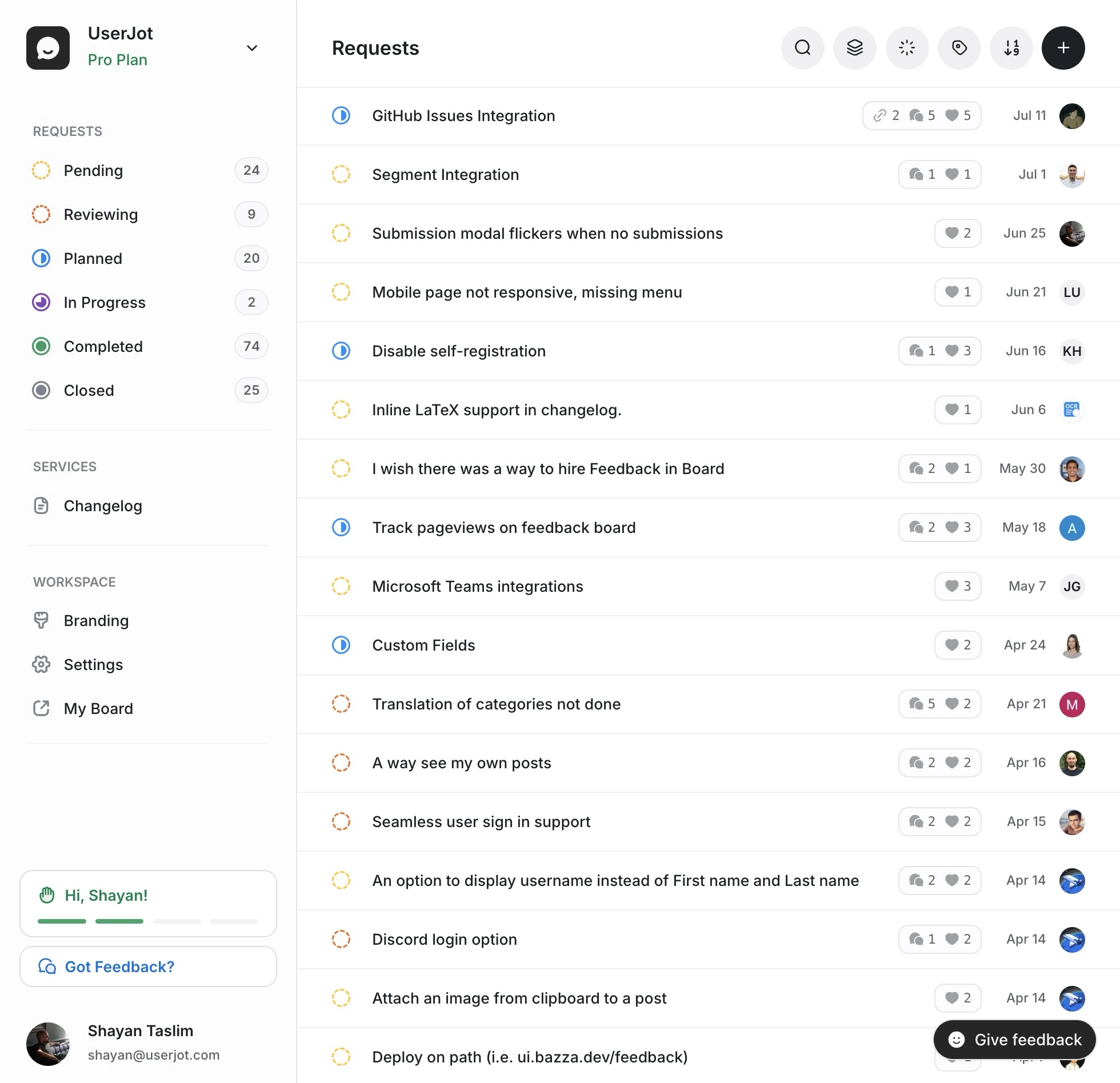Feature Creep: Why Your Product Keeps Getting Worse (And How to Stop It)

Remember when Slack was just a chat app? Open, type, send. Done.
Now it’s a “digital HQ” with huddles, canvases, workflows, clips, and 47 features fighting for that red notification dot. The app that solved communication became the problem.
This is feature creep. And it’s probably happening to your product right now.
What Is Feature Creep?
Feature creep happens when a product slowly accumulates features beyond its original purpose until it becomes complex, confusing, and worse at its core job. It’s the transformation from “this tool is perfect” to “what does this button even do?”
Think of it as product obesity. Each feature seems harmless alone—“just this one thing”—but eventually your lean product can barely move.
The symptoms are everywhere:
- New users need 30-minute onboarding calls
- Your settings page has sub-menus inside sub-menus
- Core features hide under “advanced” options
- Support tickets are mostly “how do I…” questions
- Long-time users start googling for alternatives
Why Feature Creep Happens (The Feedback Trap)
Here’s the thing: feature creep starts with good intentions. You’re listening to users. Being responsive. Building what customers want.
Someone asks for dark mode. Reasonable. Another wants CSV export. Sure. Someone needs Zapier integration. Why not?
Six months later, your simple note-taking app has become Notion’s ugly cousin.
The problem isn’t listening to users—it’s listening to all users equally without a framework for saying no.
The Hidden Cost Nobody Talks About
Everyone focuses on UX problems, but the real killer is what happens to your team.
With 200 features instead of 20:
- Every bug fix might break something else
- New developers need months to understand the codebase
- Testing becomes impossible
- Simple changes take 10x longer
- Your best engineers quit to build, not maintain
I watched a startup go from shipping daily to monthly releases. Not from laziness—because adding a button required checking 47 edge cases across their feature maze.
Real Examples You Know Too Well
Jira: From Bug Tracker to Enterprise Nightmare
Jira started simple. Create ticket, assign, close. Developers loved it.
Today? An “enterprise work management platform” with:
- 5 different board types
- Custom workflows with 73 possible states
- Permission schemes requiring a manual
- So many fields that logging a bug takes 10 minutes
Result: Teams are running to Linear, Height, and anything that just tracks bugs.
Evernote: Death by a Thousand Features
Evernote was perfect in 2012. Write notes, organize notebooks, search everything.
Then came work chat, presentation mode, document scanning, business cards, email forwarding, web clipper with 17 options, and AI nobody wanted.
Meanwhile, search got worse and sync broke constantly. They added everything except reliability.
Zoom: When Video Calls Weren’t Enough
Remember when Zoom just worked? Click link, join meeting. No account needed.
Now you navigate Zoom Apps, Events, Webinar, Rooms, Phone, Whiteboard, and their AI thing—declining to install their desktop app five times per meeting.
How to Stop Feature Creep Without Ignoring Users
You can’t ignore feedback. But you can’t build everything either. Here’s a framework that actually works.
1. Define Your One Job
Write down the single thing your product must do perfectly. Print it. Frame it.
- Slack: “Send messages between teammates instantly”
- Zoom: “Connect people on video with one click”
- Your product: ?
Every feature request gets this test: Does it make our one job better? No? It’s a distraction.
2. Use the 90/10 Rule
90% of users use 10% of features. Build for the 90%.
Be careful—the loudest “power users” requesting niche features are often a vocal minority, sometimes even free users. Meanwhile, your actual paying customers just want speed and reliability, not more buttons to navigate.
3. Make Requests Fight It Out
Don’t let feedback hide in email. Make it public. Let users see what others want.
When someone sees 500 people want dark mode but only 3 want their pet feature, reality hits. Plus, you get data on what matters versus what’s loud. (This is exactly why we made voting public in UserJot—transparency creates clarity.)
Stop guessing what to build. Let your users vote.
Try UserJot free4. Measure Everything Ruthlessly
Before adding anything, check if people use what you already built.
Most products have zombie features—zero users, but still maintained, still adding complexity. Kill them. Nobody will notice.
5. Master the “No”
You need to say no without losing users. Try this:
“Thanks for suggesting [feature]. We’re keeping our focus on [core job], but we’re tracking interest. If enough people need it, we’ll reconsider.”
Then actually track it.
The Right Way to Handle Feature Requests
The best products don’t build what users ask for—they build what users actually need, proven by data.
This is exactly the philosophy we built UserJot on. When structured feedback management replaces random emails and Slack messages, patterns emerge. Those 10 different feature requests? They’re often 10 people solving the same problem differently.
With public voting—a core feature in UserJot—noise naturally filters from real needs. That feature your loudest customer demands? If nobody else votes for it, you have your answer.
Clear prioritization backed by data beats opinions every time. A simple link to your UserJot board showing that 500 users voted for dark mode ends debates faster than another meeting. “We’re building this because the data says so” is hard to argue with.
And when users can see their request status—even just “under consideration”—they stop sending follow-up emails. Transparency reduces support load while building trust. UserJot handles all of this automatically, from status updates to email notifications.

The Feature Diet: Removing Features
Sometimes fixing feature creep means going backward. Basecamp removed features for v3. Netflix killed star ratings. Twitter removed Fleets.
Here’s how to do it right:
- Track usage for 30 days
- Find zombies (less than 5% usage)
- Warn users and provide alternatives
- Actually delete the code (don’t just hide it)
Your app loads faster. Engineers ship quicker. New users understand it immediately.
When to Say Yes
Not every request is creep. Say yes when:
- It directly improves your core job
- Majority of users benefit
- Multiple users are already hacking around its absence
- The value clearly outweighs complexity
- It meaningfully differentiates you
Dark mode? Usually yes. Blockchain integration? Probably not.
Strategic Expansion vs. Feature Creep
Here’s the nuance: some products successfully add features without becoming bloated. The difference? They expand strategically, not reactively.
Feature creep happens when you bolt on disconnected features. Strategic expansion happens when you deepen your core value proposition. Stripe added tons of payment features, but they all serve one goal: making payments easier. Every addition makes their core job stronger, not broader.
The key question isn’t “are we adding features?” but “are we deepening our solution or diluting it?”
Success Stories: Products That Stayed Focused
Linear: The Anti-Jira
Linear looked at Jira’s 200 features and built 20. Well.
No custom workflows. No permission matrices. Just issues, projects, and cycles. They reject everything else.
Result: Fastest growing project management tool, $400M valuation.
Superhuman: The $30 Email Client
Superhuman charges $30/month for email. Email!
Their secret: They do one thing—make email fast. No calendar. No tasks. No chat. Just blazing fast email with keyboard shortcuts.
Notion: Controlled Power Through Primitives
Notion could’ve become feature soup with hundreds of disconnected features. Instead, they built a system of blocks—primitives that combine infinitely.
Want a new feature? Combine existing blocks differently. Need a CRM? Database + templates. Project management? Same blocks, different layout. They added power through flexibility, not feature count. One elegant system instead of 50 separate features.
Your Feature Creep Checklist
Before adding any feature:
- Does this improve our core job?
- Will 80%+ of users benefit?
- Are we solving a real problem or perceived one?
- What’s the maintenance cost forever?
- What could we remove instead?
- Is this user need or competitor envy?
- Do we have data, not just opinions?
Can’t answer these? You’re adding creep.
The Bottom Line
Feature creep isn’t inevitable—it’s a choice. Every yes without a framework chooses complexity over clarity.
The best products don’t have the most features. They do their core job so well that users can’t imagine switching.
Your users didn’t fall in love with your product because it did everything. They loved it because it did one thing really well.
Don’t ruin that trying to do everything else.
FAQ
What is feature creep in product management?
Feature creep is when products gradually add features beyond their original scope, becoming more complex and less effective at their core purpose. It happens when teams try satisfying every request without a framework for saying no.
What’s the difference between feature creep and scope creep?
Feature creep affects products over time as capabilities expand. Scope creep affects projects when requirements grow beyond the original plan. Feature creep is a long-term product problem; scope creep is a short-term project problem.
How do you identify feature creep?
Look for increasing complexity complaints, longer onboarding times, features with < 5% usage, growing technical debt, slower development cycles, and users switching to simpler alternatives.
Can feature creep be reversed?
Yes. Many successful products have removed features. Measure usage, identify low-value features, communicate changes, and delete the code. Your product becomes faster and easier to use.
What causes feature creep?
Main causes: trying to please everyone, copying competitors, no product vision, no framework for saying no, treating all feedback equally, and FOMO on market opportunities.
What’s a famous example of feature creep?
Microsoft Word started as a simple word processor but now has mail merge, web publishing, collaboration tools, and programming features. Most users need 10% of its capabilities.
How do you prevent feature creep in agile development?
Maintain clear product vision, validate requests with data, make feedback public with voting, regularly remove unused features, and evaluate new features against your core value proposition.
What’s the relationship between feature creep and technical debt?
Feature creep creates technical debt directly. Each feature adds complexity, increases testing surface, creates bug interactions, and slows future development. More features without refactoring means more debt.
When should you say yes to feature requests?
Say yes when it improves your core job, benefits most users, solves problems users are already hacking around, provides value exceeding complexity cost, and you have data (not opinions) supporting the need.
What tools help prevent feature creep?
Feedback management tools that show user demand transparently help prevent feature creep. UserJot, for example, makes requests public and voteable so you see what matters versus noise. When you can point to actual voting data, it’s easier to say no to feature creep. Analytics tools also show which existing features actually get used.